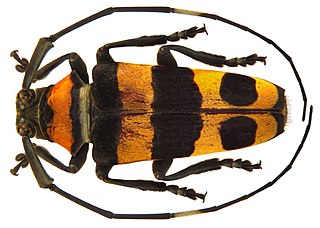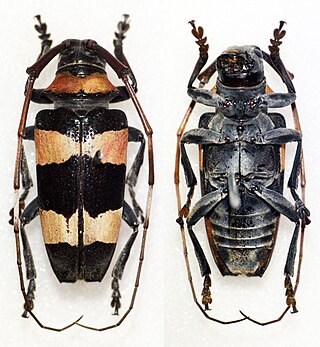
The koala or, inaccurately, koala bear, is an arboreal herbivorous marsupial native to Australia. It is the only extant representative of the family Phascolarctidae and its closest living relatives are the wombats. The koala is found in coastal areas of the mainland's eastern and southern regions, inhabiting Queensland, New South Wales, Victoria, and South Australia. It is easily recognisable by its stout, tailless body and large head with round, fluffy ears and large, spoon-shaped nose. The koala has a body length of 60–85 cm (24–33 in) and weighs 4–15 kg (9–33 lb). Fur colour ranges from silver grey to chocolate brown. Koalas from the northern populations are typically smaller and lighter in colour than their counterparts further south. These populations possibly are separate subspecies, but this is disputed.

The Terek sandpiper is a small migratory Palearctic wader species and is the only member of the genus Xenus. It is named after the Terek River which flows into the west of the Caspian Sea, as it was first observed around this area.

The red-backed salamander is a small, hardy woodland salamander species in the family Plethodontidae. It is also known as the redback salamander, eastern red-backed salamander, or the northern red-backed salamander to distinguish it from the southern red-backed salamander. The species inhabits wooded slopes in eastern North America, west to Missouri, south to North Carolina, and north from southern Quebec and the Maritime provinces in Canada to Minnesota. It is one of 56 species in the genus Plethodon. Red-backed salamanders are notable for their color polymorphism and primarily display two color morph varieties, which differ in physiology and anti-predator behavior.

Phascolarctos is a genus of marsupials with one living species, the koala Phascolarctos cinereus, an iconic animal of Australia. Several extinct species of the genus are known from fossil material, these were also large tree dwellers that browsed on Eucalyptus leaves.

The cinereus shrew or masked shrew is a small shrew found in Alaska, Canada, and the northern United States. This is the most widely distributed shrew in North America, where it is also known as the common shrew.

The barren ground shrew is a small shrew found in northern Canada west of Hudson Bay and in Alaska. At one time, this species was considered to be a subspecies of the similar cinereus shrew. It is similar in appearance and thought to be closely related to the Saint Lawrence Island shrew and Pribilof Island shrew.

The hoary bat is a species of bat in the vesper bat family, Vespertilionidae. It lives throughout most of North America.

The Daintree River ringtail possum, also known as the cinereus ringtail possum, is a species of possum found in northeastern Queensland, Australia. It was long believed to be the same as the Herbert River ringtail possum, but has recently been separated. The two species differ considerably in appearance.

The Hawaiian hoary bat, also known as ʻōpeʻapeʻa, is a species of bat endemic to the islands of Hawaiʻi. Whereas the mainland hoary bat is found throughout North America, the Hawaiian hoary bat is distributed only among the major volcanic islands of Hawaiʻi, making it the only extant and native terrestrial mammal in the state; although some studies also posit that the mainland hoary bat lives in sympatry on the Hawaiian Islands alongside the Hawaiian hoary bat, this has been disputed. The Hawaiian hoary bat was officially named the state land mammal of Hawaiʻi in 2015. It is a federally listed endangered taxon of the United States.

The Iberian worm lizard, Mediterranean worm lizard, or European worm lizard is a species of reptile in the family Blanidae of the clade Amphisbaenia. The Iberian worm lizard is locally known as cobra-cega (Portuguese), culebrilla ciega (Spanish), and colobreta cega (Catalan), all meaning "blind snake". Recent studies into the mitochondrial and nuclear genomic data of 47 isolated B. cinereus populations show rather large sequence divergence between two apparent clades, leading some researchers to call for a division of the Iberian worm lizard into two species. While little is known of B. cinereus in comparison with some other reptile species, new insight is growing about this primitive, ancestral reptile.

Cereopsius is a genus of longhorn beetles of the subfamily Lamiinae, containing the following species:

Cereopsius mimospilotus is a species of beetle in the family Cerambycidae. It was described by Stephan von Breuning in 1980. It is known from the Philippines.
Cereopsius pulcherrimus is a species of beetle in the family Cerambycidae. It was described by Stephan von Breuning in 1942. It is known from Sumatra.
Cereopsius satelles is a species of beetle in the family Cerambycidae. It was described by Francis Polkinghorne Pascoe in 1885. It is known from Borneo.

Cereopsius alboguttatus is a species of beetle in the family Cerambycidae. It was described by C. Waterhouse in 1878. It is known from Borneo.
Cereopsius amabilis is a species of beetle in the family Cerambycidae. It was described by Per Olof Christopher Aurivillius in 1913. It is known from Thailand and Borneo.

Cereopsius luhuanus is a species of beetle in the family Cerambycidae. It was described by Heller in 1896. It is known from Sulawesi and Moluccas.
Cereopsius obliquemaculatus is a species of beetle in the family Cerambycidae. It was described by Karl-Ernst Hüdepohl in 1989. It is known from Borneo.

Cereopsius quaestor is a species of beetle in the family Cerambycidae. It was described by Newman in 1842, originally under the genus Monohammus. It is known from the Philippines and Moluccas.
Cereopsius sexnotatus is a species of beetle in the family Cerambycidae. It was described by James Thomson in 1865. It is known from Malaysia and Java.













